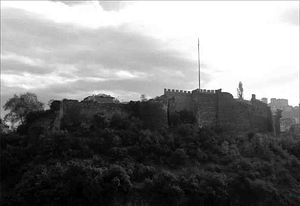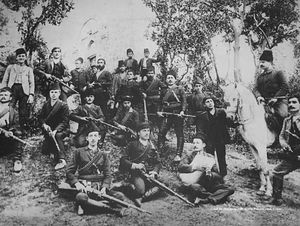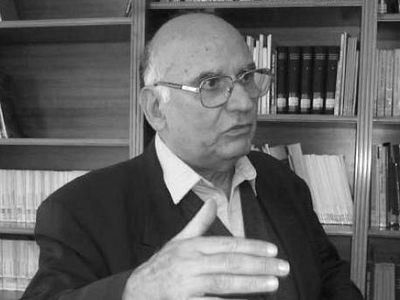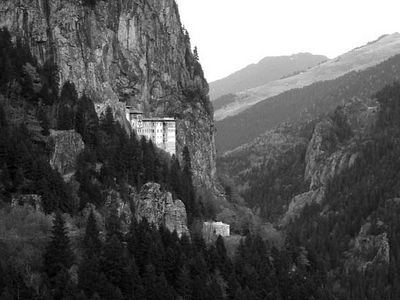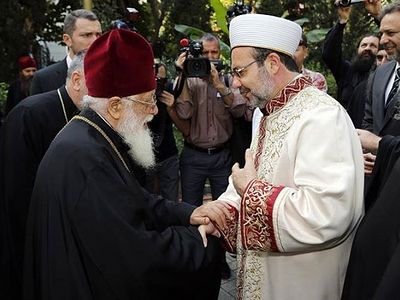Kromni’s Churches Restored
Although, as I mentioned, the first mosque was erected in Kromni in 1815, the first church was only built sixteen years later by professed Christians who had begun moving to the area in the 1700s to work in the mines. This church came about during the reign of Sultan Mahmud Han II (1808-1839), who decreed that ruined Christian churches might be restored. As the remains of a 13th-century church could still be seen in the Kromnean village of Samanandon, the crypto-Christians encouraged the professed Christians to petition the Sultan to allow them to rebuild.
The Sultan sent his approval in a firman (decree) in 1830, stating that, “those who petitioned and begged for the restoration of the ruined church at Siamanli (Samanandon) diocese… after examination and inspection by officials of my office, this truth has been proven and established that the dimensions of the church are twenty-seven by thirteen…. In answer to whether it is possible to allow for its restoration, the answer is yes, but without the right to exceed even an [inch] of the initial limits of the building, and to restore it without receiving one [penny] or grain of wheat as compensation.”[1]
The Church of St. George was finished and dedicated in 1831. The crypto- Christians could admire it, but none could go inside; such a deed would have jeopardized their secret. As the century progressed and the laws were further relaxed, the professed Christians of Kromni built more new churches, each time at the instigation and support of the crypto-Christians, who aided them by minimizing Ottoman reaction. In this way, by the end of the century, every hill and mountain peak had its Christian church. It was as if our centuries-old underground crypto-Christian chapels had taken root, germinated, and sprouted forth on the surface of the earth.
The Greek Revolution
During the reign of Sultan Mahmut B (1808-1839), the first of several great “earthquakes” occurred in the lives of the crypto-Christians. The first was the news in March of 1821 that the Greeks of the Peloponnese, led by Metropolitan Germanos of Patras and joined by others on the Greek mainland, had risen in revolt against Ottoman rule. When the news reached the Sublime Port, and the sleeping Sultan was awakened with the news, he allegedly rolled on the floor screaming in rage, “Rum ismi ile kulum yoktur, kesin kafalarini.” “I do not recognize any Greek subjects, off with their heads.” The first Greek executed in retaliation was Patriarch Gregory V of Constantinople, who was held responsible for the uprising and hung from the middle gate of the courtyard of the Patriarchate of Constantinople. In memory of his tragic death, this gate has remained closed until now. Another twelve hierarchs lost their lives for the same reason.
When the Ottomans of Asia Minor heard of the Greek insurrection, there was a fierce backlash and Trebizond’s governor, Hesref Pasha, gathered the city’s professed Christians into the Ottoman citadel, the Leontokastro, intending to execute them. They were saved only through the efforts of the Ottoman Muslim military commander, Pasha Satir Zade, who warded off the unjust slaughter. Although the news of the Peloponnese revolt was welcomed in the crypto-Christian community, the initial joy was overshadowed by the death of the patriarch, and Kromni’s crypto-Christians worked quickly to counter attempts to fanaticize Kromni’s Muslim neighbors against the professed Christians.
The second great upheaval was the Russian-Turkish war of 1828, when the Russians conquered Kars and Ezerum in the East, occupying territory all the way to Trebizond and Argyroupoli. The metropolitans of Trebizond and Chaldia advised their crypto-Christian flock to wait, and Mullah Molasleyman himself went from house to house through the villages of Kromni, warning the crypto-Christians not to reveal themselves. Yet quite a number did not heed his advice, and assuming that the Russians were there to stay, openly proclaimed themselves Christian.
When the war ended a year later, by the terms of settlement, the Russian troops left Pontus. They were followed to southern Russia by more than two thousand of these newly-revealed Christian families, now liable to Islamic penalties for apostasy.
The Hatti Sherif of Gulhane and the Death of Mullah Molasleyman
Upon ascending the throne in 1839, Sultan Abdul Medjit I signed a decree, the Hatti Sherif, formulated by his Foreign Minister and Grand Vizier, Reshid Pasha, that Ottoman Christian subjects were now free to practice their faith and to build new churches, schools, and other foundations. It is not known if this was initiated in order to follow in the relatively tolerant footsteps of Mehmet the Conqueror, or whether he simply wanted the Ottoman Empire to appear more civilized in the eyes of the West. In either case, the proclamation was jubilantly welcomed and new churches were raised in every Christian neighborhood.
Again, the Church authorities counseled the crypto-Christians to wait and not reveal themselves. This decree concerned only the freedom of the professed Christians; nowhere did it say that Muslims could abandon their faith and follow another religion. In theory, the traditional edict of Malik Ibn Anas of 795 AD still held: Mohammed the Prophet had decreed that apostasy from Islam was punishable by death.
The uncertainty lasted for five years, the hierarchs justifiably uneasy over the arrest and imprisonment of several Armenian crypto-Christians resident in Turkey, who had openly declared their religion at the time of the decree. This also occurred in Trebizond, where, in 1843, an Armenian Christian still awaited trial.
In Kromni and other crypto-Christian areas, however, the mullah-priests were under pressure to clarify the situation. Kromni was now filled with beautiful churches built by the professed Christians but the crypto-Christians could not visit them, and reluctantly continued to pray in their underground chapels. In 1843, the Kromneans insisted that Mullah Molasleyman, now 83 years old, but still active, in good health, and the acknowledged spokesman for the crypto-Christians of Kromni, go to Trebizond to meet secretly with Metropolitan Konstantinos III to discuss the matter.
At this time the governor of Trebizond was another Osman Pasha (1839- 1843) – not the one who had saved the Christians in 1921. Mullah Molasleyman arrived in the city around Pentecost, staying with his brother in the Trebizondan neighborhood of Molos. The metropolitan was notified of his arrival, and at their meeting the mullah explained that the crypto- Christians were becoming impatient, and he could not answer for their secrecy much longer. The metropolitan and the mullah agreed to wait for the verdict in the approaching trial of the Armenian; in any case, the Kromneans would do nothing until the mullah’s return. On Pentecost, the mullah served liturgy in the secret chapel of the house in Molos, attended by the families of his two brothers and crypto-Christian relatives from Trebizond. He gave them Holy Communion and advised everyone to go to sleep early, because, according to custom, on the following day, the Monday of the Holy Spirit, it was forbidden to sleep the entire day in honor of the descent of the Holy Spirit.
On Monday morning, the mullah, who intended to serve liturgy at the home of his other brother in Kemerkaya, was awakened, as was the rest of Trebizond, by town criers calling out the news that the poor Armenian had been condemned to death the night before. Osman Pasha, it was said, had tried to forestall the verdict, but was pressured (or blackmailed) by the Mufti members of the Islamic court, and had finally yielded. At dawn, on the Feast of the Holy Spirit, the Armenian was hung.
After years of expectation, the tragic conclusion of the trial and the collapse of all their hopes was more than Mullah Molasleyman could bear. Crying “Water, water!” he dropped to the floor dead. He died without seeing the fulfillment of his life’s dream – to serve openly in a church before God and man.
The metropolitan, who was immediately notified, sent a priest to perform the Christian funeral in the home of the mullah’s brother in Kemerkaya, in the presence of his relatives. Meanwhile, the public “Muslim” funeral was being prepared in Molos, with the hot water bath administered by those especially appointed in the Muslim community. Because he was publicly known as a Muslim mullah, they held the Muslim service in the mosque, which was attended by many Muslims and officiated over by a mullah. He was buried in the Muslim cemetery.
With the news of the Armenian’s hanging and the sudden death of Mullah Molasleyman, the Christian community froze. Even the enthusiasts no longer spoke of revealing themselves. Late in the same summer, Osman Pasha himself reposed, and it was generally believed that his signature condemning the Armenian was too heavy for his soul and had killed him. With the Armenian’s death, Turkish extremism declined and even the Muslim community began criticizing the lack of religious freedom.
The crypto-Christians visited the Muslim cemetery for many years, quietly whispering memorial services and praying at the graves of Mullah Molasleyman and their other relatives. Later, after they revealed their Christianity, this was no longer allowed, as the Muslims did not want them to pray Christian prayers over the graves of their “Muslim” ancestors.
If you go to Turkey now, you may enter a Mohammedan cemetery even if you are not Muslim. At that time, however, if you were openly Christian (or later, when it was safe for the crypto-Christians to reveal themselves) you were not allowed to pray at the graves where your “Muslim” ancestors were buried, or even to enter the cemetery. It happened, however, that some very poor Trebizond families had built their houses onto the city wall overlooking the cemetery because this saved them the expense of one wall. My grandmother Aphrodite remembers that one of these two-storey houses was owned by an Armenian Christian widow and my grandmother’s family would pay a little money to the widow to allow them to serve an Orthodox memorial service for Mullah Molasleyman through the window overlooking his grave. These women, who came especially on the Saturday of All Souls, were in truth new myrhh-bearers, faithfully fulfilling their duties to God and their beloved dead.
Unfortunately, this cemetery was destroyed by the Russian army in 1916 when they occupied Turkish Trabzon and extended the medieval road running through the city, so that the new neighborhoods outside could be reached directly without having to walk all the way around the city wall. The old cemetery was covered by what is now Maras Street, from the main square to the new gate.
The Closing of the Mines
After 1843, when new deposits of gold and silver were discovered in South Africa, the price of gold fell to one-tenth of its former value on the international market. The Sultan was able to obtain these precious metals for less than the cost of mining the ore in Turkey, and the Kromni mines began to close. By 1854, many Kromneans had emigrated to Batum and other cities on the Russian Black Sea Coast, where they could freely practice their Christianity. Others went to work in the Armenian mines, in a village called Alahkverdi (“God gives”) where Greeks still reside today, while the majority who stayed changed their livelihood to producing and selling metal-work objects.
Some of those who elected to stay within the Ottoman Empire left for other mines in Asia Minor – Cilicia and Ak Dag Magen, while other Kromneans changed professions completely, and in Trebizond or surrounding villages worked as builders, carpenters, shoe-makers, tailors, blacksmiths, bakers, coppersmiths, millers, and so on. Being crypto-Christian in the larger cities was more dangerous, because of the greater chance of discovery.
Faith Revealed: The Hatti Humayun
Under international pressure from Christian Europe, on February 17, 1856, seventeen years after authorizing the Hatti Sherif of Gulhane, Sultan Abdul Medjit I signed into effect the Hatti Humayun, an edict granting every Ottoman citizen freedom of religion and safeguarding the ability to change religions.[2] However, he signed in complete ignorance of the great number of crypto-Christians waiting to reveal their faith. Judiciously cautious, as they needed to be, the Pontic crypto-Christians were slow to declare their belief. The first was the “Muslim” doorkeeper of the Italian Consulate, Pehlil Tekiroglu. Basing his revelation on the Hatti Humayun, he disclosed his Christianity to his chief, the Italian Consul Fabri, who initially did not believe him, but once convinced, encouraged Pehlil to reveal his faith, pledging his support. Pehlil went to Hairedin Pasha, the governor of Trebizond, and subsequently appeared before a full quorum of the Idare-i-Meclisi, the Muslim court, on May 14, 1856. Three times, Hairedin Pasha asked him what he believed, and each time Pehlil confessed that he was baptized a Christian with the name Petros. Without any other formalities, Hairedin Pasha accepted him as a Christian with the name Petros Savva Sidiropolous. One such person probably seemed an anomaly, an opportunity to show widespread toleration. Little did Hairedin Pasha guess that this was the breech in the dike. At this time, Konstantinos III was still enthroned as the Greek Metropolitan of Trebizond, and in March 1857, a year after the revelation of Petros Sidiropoulos, 150 crypto-Christian village leaders went to the Monastery of Theodkepastos in Trebizond and inside the church took an oath to reveal their Christianity and to remain faithful in the face of exile or death. They signed a written oath, gathered a collection, and appointed two representatives, one of which was Petros Sidiropoulos and the other Dimitrios Voskopoulos, whose Muslim name was Suleyman. Sidiropoulos and Voskopoulos made the rounds of Constantinople’s European consulates presenting their resolution. With only one exception, they found the consuls deeply moved, accepting of the resolution, and promising to help. Their single rejection was by the English consul, A. Stevens, who saw them as liars and opportunists seeking to escape Turkish military service after the closure of the mines, and declared as much in a report to the British embassy in Istanbul.[3]
The massive revelation fell like a bomb at the Ottoman Court, and the state renamed the crypto-Christians, Tenesur Rum (Those Who Rejected). Initially, the Turks accepted this incident with irony. In Trebizond they had a saying about Uzun Sokak, the city’s large commercial street, Uzun Sokak camur oldu, Krumillar giavur oldu. (“Uzan Sokak filled with mud, and the Kromneans became infidels.”) After the revelation, the Turks called Kromni, Kücük Yunistan (Small Greece).
Then the reaction began: Ottoman authorities began registering the revealed crypto-Christians under both their Muslim and Christian names, and, as the mines closed, called them up for conscription. Non-Muslims had never been allowed to serve in the Ottoman army, paying a special tax instead, but if the former crypto-Christians were registered under their Muslim names, and no longer exempt from conscription by their work in the mines, they would be taking up arms against neighboring Christians, while serving in a Muslim army that considered them traitors and apostates. Further, revealed crypto-Christian children were not allowed to inherit property, goods, or money that had belonged to their “Muslim” parents.
To forestall these penalties, revealed crypto-Christian families began sending their young newly-married couples to southern Russia or Georgia to establish their families in a free Christian state. Others later left for Russian controlled Batum and Kars, and by 1910 there were few former crypto- Christian families remaining in Pontus, although the number of professed Christians had actually increased. Stavrin, the last Kromnean crypto-Christian village to reveal itself, did not do so until 1911, by which time Turkey had a constitutional government. The angry Turkish authorities demanded, “Where have you been for so long?” and the revelation seemed on the verge of backfiring until, bowing to European pressure, the Turkish National Assembly passed a resolution accepting the village as Christian. Now, I have a story to close this period. At the first wave of crypto- Christian revelations, Ottoman administrative committees were set up in every area where crypto-Christians had begun declaring themselves. The committees were headed by a Turkish Muslim administrator representing the Ottoman government, a policeman, and a representative of the Greek Church. Each villager appeared in turn before his local committee, declared his faith, his real name, and was registered as a Christian.
One such committee operated in Tzevisluk, 27 kilometers from Trebizond, where, on a certain day, crypto-Christians from the surrounding villages were to come and register. Towards afternoon the lines had dwindled, and by nightfall the last villager had been heard. “So, we are finished,” said the policeman, closing the book. “Let us wait a bit longer,” replied Mullah Vaizoglu, the Ottoman administrator, “to be sure that there is no one else.” When some time had passed and no one else came, the mullah himself stood and said: “Register me as well. I am Georgios Kirittopoulos, the priest of Kapikioy.” Today this man’s descendants live in Kavala and Kozani in northern Greece; their name comes from the Greek word Kyrix, “the one who prays.”
We cannot overestimate the importance of these mullah-priests, who outwardly led their communities as devout Muslims, while keeping their secret Christian beliefs and traditions alive. Tonya and Of, the two originally crypto- Christian Greek-speaking areas that did not have a line of secret priests, surrendered their Christianity for Islam long before the 1856 revelation. In the illiteracy and darkness of the times, only Christ through His priesthood could sustain the spirit and souls of these simple peasants and keep the faith, like a bright flame, burning in their hearts.
